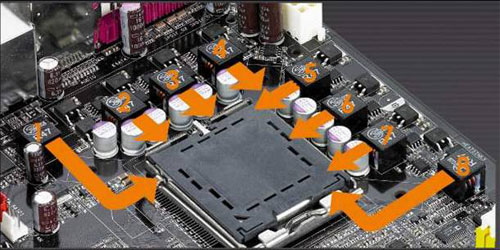Asus A8N32-SLI Deluxe: NVIDIA Dual x16 for the Athlon 64
by Wesley Fink on November 6, 2005 9:00 AM EST- Posted in
- Motherboards
8-Phase Power and Dual x16 PCIe
Two areas really stand out with the new Asus A8N32-SLI. First, this is the launch of a true dual x16 SLI board. That means that you can bridge two video cards at full x16 speed in each slot instead of the x8 speed of current SLI.
8-Phase Power
The new Asus 32-SLI boards, both the recently tested P5N32-SLI for Intel processors and this A8N32-SLI for AMD, are the first 8-phase desktop boards that we have tested. Those who have questioned whether the design is truly 8-phase will be interested in this shot with the MOSFET heatsinks removed on the Intel version. There are 8 coils and 8 banks of MOSFETS along the two sides of the CPU.
Low ripple voltage can stabilize the CPU at working voltage, but it also can increase the over-clocking margin. An Asus White Paper uses the analogy of ripple voltage being like waves in an ocean and the CPU is like a boat. It is very hard for a boat to go forward in big waves (High ripple voltage), and the big waves can even turn the boat around (Burnout of the CPU). On the other hand, it is easy for a boat to move forward in small waves (Low ripple voltage), and the boat can even go faster (Overclocking the CPU) in an ocean with small waves.
The other advantages of 8-phase are a current reduction of up to 50% compared to 4-phase, which can yield a power reduction of about 25% over 4-phase. This even applies to a reduction in power consumption in a high-end CPU. Asus claims that a CPU requiring 130W in a 4-phase design will see a 10% reduction in power consumption in an 8-phase design.
Dual x16 PCIe
While both the P5N32-SLI for Intel and this A8N32-SLI for AMD provide two full speed 16-bit slots for SLI, they use a slightly different set of chipsets to drive this feature. This AMD version uses what is basically a C51 Northbridge chip without integrated graphics for the A8N32-SLI North Bridge and an nForce4 SLI chip for the South Bridge. In this hybrid design, each bridge drives one x16 slot and a total of 40 PCIe lanes are available to the board.
The Intel processor solution from NVIDIA uses the Intel C19 for the Northbridge and the same nForce4 SLI for the South Bridge. The 2 chips communicate via a Hypertransport link just like the chips in the AMD solution.
Whatever the differences in approach, both the Intel and AMD versions provide full dual x16 PCIe slots, which can be combined into Dual x16 SLI video. There are also other potential design uses as you saw in the Gigabyte quad PCIe review, where the board could enable four x8 PCIe slots to drive up to 10 monitors.
Two areas really stand out with the new Asus A8N32-SLI. First, this is the launch of a true dual x16 SLI board. That means that you can bridge two video cards at full x16 speed in each slot instead of the x8 speed of current SLI.
8-Phase Power
The new Asus 32-SLI boards, both the recently tested P5N32-SLI for Intel processors and this A8N32-SLI for AMD, are the first 8-phase desktop boards that we have tested. Those who have questioned whether the design is truly 8-phase will be interested in this shot with the MOSFET heatsinks removed on the Intel version. There are 8 coils and 8 banks of MOSFETS along the two sides of the CPU.


| CPU Current 100A | 2-Phase | 3-Phase | 4-Phase | 8-Phase |
| Input Ripple Current (A) | 22.63 | 16.508 | 12.359 | 4.463 |
Low ripple voltage can stabilize the CPU at working voltage, but it also can increase the over-clocking margin. An Asus White Paper uses the analogy of ripple voltage being like waves in an ocean and the CPU is like a boat. It is very hard for a boat to go forward in big waves (High ripple voltage), and the big waves can even turn the boat around (Burnout of the CPU). On the other hand, it is easy for a boat to move forward in small waves (Low ripple voltage), and the boat can even go faster (Overclocking the CPU) in an ocean with small waves.
The other advantages of 8-phase are a current reduction of up to 50% compared to 4-phase, which can yield a power reduction of about 25% over 4-phase. This even applies to a reduction in power consumption in a high-end CPU. Asus claims that a CPU requiring 130W in a 4-phase design will see a 10% reduction in power consumption in an 8-phase design.

Dual x16 PCIe
While both the P5N32-SLI for Intel and this A8N32-SLI for AMD provide two full speed 16-bit slots for SLI, they use a slightly different set of chipsets to drive this feature. This AMD version uses what is basically a C51 Northbridge chip without integrated graphics for the A8N32-SLI North Bridge and an nForce4 SLI chip for the South Bridge. In this hybrid design, each bridge drives one x16 slot and a total of 40 PCIe lanes are available to the board.
The Intel processor solution from NVIDIA uses the Intel C19 for the Northbridge and the same nForce4 SLI for the South Bridge. The 2 chips communicate via a Hypertransport link just like the chips in the AMD solution.
Whatever the differences in approach, both the Intel and AMD versions provide full dual x16 PCIe slots, which can be combined into Dual x16 SLI video. There are also other potential design uses as you saw in the Gigabyte quad PCIe review, where the board could enable four x8 PCIe slots to drive up to 10 monitors.










95 Comments
View All Comments
GliderPilot - Monday, January 9, 2006 - link
Well i have finally gotten my replacement board, and again i have a major issue with it. It seems that in some fit of wisdom, one of asus's underpaid engineers placed a heatpipe right in the way of the x4 PCIe slot. You might not have a use for them, but i certainly do. I have a PowerColor Theatre 550Pro x1 TV Tuner that is right now occupying an x16 slot. While i dont intend to do SLI, i would dearly like to have dual tuners without having to have one on pci, the other on PCIewbloon - Sunday, December 18, 2005 - link
I'm not a big gamer. But I currently drive 2 monitors and with the new system want to drive at least 3 monitors and possibly a TV.So my question is can I drive two video boards but not in SLI mode, since it is my understanding that SLI will only drive one monitor.
I understand that I could get away with a board like the DFI Ultra and have 16 lanes to one card and 4 lanes to another and that would probably meet my needs but I'd like stretch the envelope where ever possible because the future keeps coming despite my best efforts.
Terry Clark
GliderPilot - Monday, January 9, 2006 - link
unless you are gaming on both cards (which probably wont) having 4 lanes is more than sufficient. The bandwidth would be comparable to AGP4 in the downstream. This solution is about as future proof as it gets. To answer your question, yes this board basically has 2 full bandwidth X16 slots, what you do with them is up to you. Buying this board soley for the extra 16 lanes is really a waste of money, unless there is some other reason you like itBibbidyBobidyBoo - Wednesday, December 7, 2005 - link
I recently purchased this motherboard and an Antec NeoHe 550W PS and the combo worked great for about 5 to 10 min and then the computer spontaneously shuts down. The issue is with the PS not the MB. The Antec TruePowerII 550W PS works just fine. I believe the incompatibility is from the amount of current supplied on the 12V and 5V lines, it may match the ATX2.2 spec however it is not completely backwards compatible with this Asus MB.Beware this issue has also been noted on other Asus MB’s.
http://www.newegg.com/Product/CustratingReview.asp...">Newegg Customer Reviews">http://www.newegg.com/Product/CustratingReview.asp...
JNo - Thursday, November 10, 2005 - link
Can someone confirm to me that no single x16 video slot version of this Asus motherboard exists? I get the impression that none does. Also, anyone know if the latest zalman CPU coolers fit? Finally, I know most here wouldn't care for the Asus automatic overclocking results but for someone like me, can you please inform me, Wesley, as to how much of a boost does the inbuilt Asus overclocking facility provide please?Many thanks
Capt Caveman - Monday, November 14, 2005 - link
Umm, this new chipset is for SLI, thus the chipset name x16 SLI. The pci-e video slot is already x16 on every single video slot socket 939 pci-e motherboard. Up til now, SLI motherboards had to split the x16 into two x8 pci-e graphic slots. Thus, you will never see a single slot video care motherboard using this chipset.And yes, it has been confirmed by current users that the Zalman coolers fit.
Due to the fact that Asus's Overclocking Utilities lack a number of settings that are available in the bios, ie. memory settings, you'll only be able to get a small overclock before the system becomes instable. Overclocking via the bios is the only way to go to ensure a stable overclock.
qquizz - Sunday, November 6, 2005 - link
Whatever happened to BF2 benchies?huges84 - Monday, November 7, 2005 - link
Quoted from page 7
DieLate - Sunday, November 6, 2005 - link
Wesley, any chance of a measurement of northbridge & "stack cool" heatsinks? If you or someone else with one could measure how high off the motherboard they rise, that would be great.I'm hoping the Thermaltake Big Typhoon or Thermalright SI-120 would fit, as they have somewhere around 2" raised off the board (though the heatpipes might still hit the northbridge heatsink :( ).
DieLate - Tuesday, November 8, 2005 - link
Nevermind.I have confirmed elsewhere the TT BT fits without any issues.